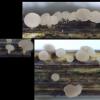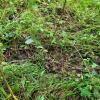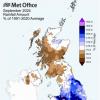
01-01-2026 18:35
Original loamy soil aside a artificial lake.The co

31-12-2025 19:27
Collected from loamy soil, at waterside (completel

30-12-2025 16:44
Pascal DucosBonjour,Une anamorphe rose stipitée, très nombre

30-12-2025 17:14
 Bernard CLESSE
Bernard CLESSE
Bonjour à toutes et tous,Pourriez-vous aider Albe

29-12-2025 10:15
Hulda Caroline HolteHello, I found and collected this propoloid ascom

30-12-2025 09:04
Hello.A Pyrenomycete sprouting sparsely but very d

29-12-2025 17:44
Isabelle CharissouBonjour,J'aimerais savoir si d'autres personnes au
Hymenoscyphus s.s. on various herbaceous stems
B Shelbourne,
28-10-2024 17:51
• Spores and excipulum suggest H. s.s., but the apothecia have a more grey colour than I have seen before.
• It looks similar to H. fucatus but the spores are slightly shorter on average.
• Otherwise, there are similarities with H. scutuloides but the spores are wider, or H. aff. vitigenus but the LBs in the spores seem different.
Habitat: On dead stems of various herbaceous plants, including Urtica dioica and possibly Bromus slyvaticus and Rubus fruticosus agg., on the ground, wet when found and ground muddy, generally shady and damp area, on the side of a low bank, separated from a small river by a path, flooding in very wet weather, after rain, Salix nearby, mixed deciduous woodland, Low Weald, southern England, late-October.
Apothecia: Many thousands, even hundreds on some stems, < ~1 x 2 mm, gregarious to 3-4+ caespitose, whitish when immature but soon becoming reddish-grey colour, darker with age, cupulate to discoid, disc apparently soon becoming plano-concave, sub-stipitate to stipitate.
Low magnification: Receptacle more brownish, disc whitish and slightly pruinose, margin relatively indistinct but often slightly darker, undulating more in larger apothecia, stipe like receptacle but often slightly more translucent, obconical to narrow-cylindrical, two appear fused at the stipe, .
Asci: Cylindrical-clavate, with croziers, rings bb, Hymenoscyphus type.
Spores: Ellipsoid-fusoid to slightly clavate, mostly heteropolar, then with the apex more rounded and the base more acute, slightly curved or asymmetric in profile view, and often slightly scutuloid and slightly restricted in the centre, 2-4 large LBs and many smaller ones, possibly some very short setulae seen occasionally, apparently uninucleate when mature, but becoming uniseptate outside the ascus and more oblong to distinctly clavate, some with brownish walls, two septate spores seen germinating from the side close to the hook and septa or the basal end.
- Apothecia 1, free spores or stuck to the receptacle, many septate, in water: (20.1) 20.2 - 23.0 (23.7) × (5.0) 5.4 - 6.6 µm, Q = (3.2) 3.3 - 4.1 (4.5), N = 24, mean = 21.7 × 5.9 µm, Q mean = 3.7.
- Apothecia 2, discharged from asci, aseptate, in water: (20.1) 20.6 - 25.0 (25.4) × (4.8) 5.0 - 6.0 (6.5) µm, Q = (3.2) 3.8 - 4.8 (5.2), N = 20, mean = 23.2 × 5.5 µm, Q mean = 4.3.
Paraphyses: Narrow-cylindrical, apex with Hymenoscyphus type VBs, VBs relatively large and sometimes hard to resolve or coalescing quickly.
Structure of the excipulum seems comparable to other species in Hymenoscyphus s.s., but lots of organish-brown exudate in the ectal excipulum, inside the stipe, and around the external network of hyphae.
Enrique Rubio,
28-10-2024 21:27
Re : Hymenoscyphus s.s. on various herbaceous stems
Did you compare it with Hymenoscyphus scutula?
B Shelbourne,
28-10-2024 22:21
Re : Hymenoscyphus s.s. on various herbaceous stems
Thank you. I have not compared this with H. scutula, because it is reported with simple septa and long setulae.
Enrique Rubio,
28-10-2024 22:42
Re : Hymenoscyphus s.s. on various herbaceous stems
Yes, you are right, scutula has simple-septate ascus base.
Hans-Otto Baral,
29-10-2024 10:02

Re : Hymenoscyphus s.s. on various herbaceous stems
I think this fits well H. macroguttatus. That species has homo- or only slightly heteropolar (scutuloid) spores.
Can you tell me the collection date please?
B Shelbourne,
29-10-2024 10:39
Re : Hymenoscyphus s.s. on various herbaceous stems
Thank you.
I would have to agree, and I see now that the greyish colouration is mentioned. I had thought the spores looked very much like H. macroguttatus, and it has croziers. However, most reports of the spores are considerably smaller (not overlapping on length).
Even looking at your detailed study from 2007 and reviewing my measurements for the aseptate spores, many are in the extremeties of the lengths and some are still wider than your maximum width. I think the 6.5 um wide spore is abnormal but without this the widths are (4.8) 5.0-6.0 and you give (3.5) 3.8-5.0 (5.5).
I would have to agree, and I see now that the greyish colouration is mentioned. I had thought the spores looked very much like H. macroguttatus, and it has croziers. However, most reports of the spores are considerably smaller (not overlapping on length).
Even looking at your detailed study from 2007 and reviewing my measurements for the aseptate spores, many are in the extremeties of the lengths and some are still wider than your maximum width. I think the 6.5 um wide spore is abnormal but without this the widths are (4.8) 5.0-6.0 and you give (3.5) 3.8-5.0 (5.5).
B Shelbourne,
29-10-2024 10:52
Re : Hymenoscyphus s.s. on various herbaceous stems
P.S. These were collected on 25/10/24 but I first noticed them on 9/10/24.
Hans-Otto Baral,
29-10-2024 11:23

Re : Hymenoscyphus s.s. on various herbaceous stems
Yes, I must agree. However, in my files I have a specimen by E. Batten with long but narrow spores:
Hymenoscyphus macroguttatus, EB 4638: *22-25 x 4-4.2 µm.
Also one of mine
Hymenoscyphus macroguttatus, HB 7034: *16-24 x 4.2-4.6 µm.
Your asci are also extraordinarily large, especially wide. It would be valuable to measure the turgescent asci for comparison (I found about 125 x 15 µm in contrast to about 100 x 10.5 µm in typical macroguttatus).
ITS sequences exist for 5 samples with a HB number, and they are all fully identical.
B Shelbourne,
29-10-2024 13:19
Re : Hymenoscyphus s.s. on various herbaceous stems
Ok, I have several photos so I can measure the turgid asci later. In the second apothecia I sectioned, which was at room temperature, the asci were highly turgid and many discharged within a few minutes.
I wonder if the size could be environmental, it seems to have been ideal this year judging by the number of apothecia and duration of fruiting. I recently saw that England and especially southern England had a very wet September.
B Shelbourne,
29-10-2024 16:35
Re : Hymenoscyphus s.s. on various herbaceous stems
These are the measurements I got for the asci that look turgid:
Apothecia 1: 106-123 (130) × 13.0-14.5 (15.0) µm, N = 12, mean ~116 × 14 µm.
Apothecia 2: 114-120 x 12.6-14.0 µm, N = 4, mean ~116.5 x 13.5 µm.
Apothecia 1: 106-123 (130) × 13.0-14.5 (15.0) µm, N = 12, mean ~116 × 14 µm.
Apothecia 2: 114-120 x 12.6-14.0 µm, N = 4, mean ~116.5 x 13.5 µm.
Hans-Otto Baral,
29-10-2024 21:39

Re : Hymenoscyphus s.s. on various herbaceous stems
o.k., still too high I presume. I cannot imagine such influence of the humidity but who knows.







 Excipulum-0017.jpeg
Excipulum-0017.jpeg